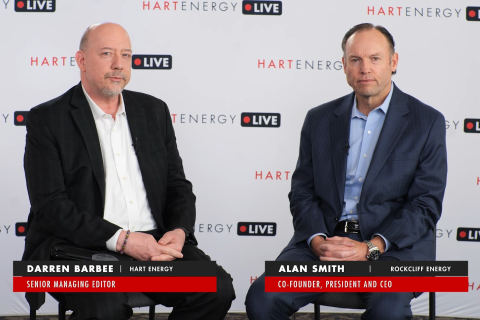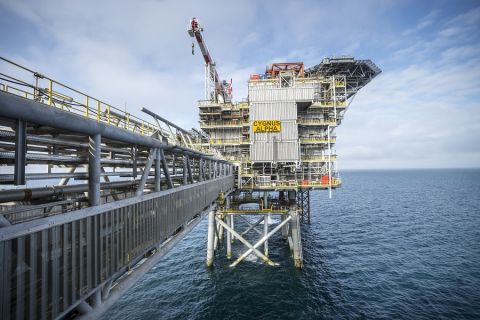The oil and gas industry, and the exploration and production sector in particular, has been blessed by the significant strength in hydrocarbon wellhead prices during the past two years. While most E&P shares have enjoyed impressive market appreciation from a low in April 1999, they have lagged the even more robust performance of the two commodities-natural gas and oil. (See chart.) Taking into consideration the mild backwardation in futures prices (the forward markets indicate commodity prices are expected to drift lower by roughly 10% to 15% from current spot levels of $27 per barrel of oil and $5 per million Btu of gas in the future), E&P equities seem quite cheap. Arguably, many pure E&P companies-especially North American natural gas producers-are trading at less than the intrinsic value they offer, based on the futures market. Energy executives are "teased by the strip." Why are E&P shares so undervalued? Oil companies have a depressing history of wasting free cash flows at the top of the commodity cycle. Flush with cash flow from commodity windfalls, oil executives have historically spent this largesse overpaying for acquisitions (surely, size of enterprise rather than wealth creation has been the primary driver of executive compensation) and on dubious "growth" or exploration schemes. For example, the short-lived "drilling boom" in 1997 resulted in a spike in finding and development costs (John S. Herold Inc.'s analysis found that average FDC in 1998 among large domestic E&P companies was an eye-popping $10.53 per barrel of oil equivalent). Similarly, prices paid for producing properties spike during periods of strong wellhead values; Herold's M&A Transaction Review chronicled a dramatic doubling of the implied value of reserves acquired in North America in the first quarter of 2001, compared with year-ago levels. (See chart.) Herold analysts gauge Shell Oil 's spurned $55-per-share offer for Barrett Resources as equivalent to $9 per proved barrel of oil equivalent of reserves or $1.50 per thousand cubic feet of gas equivalent. (Both of these figures are about twice the historical norm buyers have paid for reserves.) In the wake of the sharp rebound of drilling activity from the 1998-99 industry recession, preliminary 2000 data indicate finding costs are creeping up again. With nearly all E&P companies planning to increase their spending, Herold expects North American finding costs will surge again in 2001. Anecdotal evidence from downtown Houston points to a 30% to 35% advance in drilling and completion costs this year. That's right, this means spending 35% more for the same level of activity as last year. The boom-bust track record of the petroleum sector during the past two decades continues to haunt oil executives. Only a handful of E&P companies have managed to create wealth for their shareholders, i.e. a better than 10% internal rate of return (IRR) for investors on common shares over the 1980s and 1990s. Consequently, despite the solid profitability of E&P companies of late, Wall Street investors are taking a cautious-even cynical-approach to the sector. This should be no surprise. If investors reasonably expect a large amount of future cash flows to be squandered, they will heavily discount the present value of future cash flows in E&P company valuations-which has precisely been the case. A three-cornered strategy What can be done to close this so-called value and credibility gap? Herold and Stern Stewart & Co. have concluded that one logical answer would be for E&P companies to commit to paying out today's high future cash flows to shareholders now. By paying out cash windfalls to shareholders in a tax-efficient manner, companies can create tremendous wealth for shareholders, while holding on to the upside of future growth and development opportunities. To accomplish this, management could execute a three-cornered strategy: • Price-hedge those volumes from the proven developed producing (PDP) layers, • Borrow against the present value of those, now certain, future cash flows and, • Return that cash to shareholders by repurchasing shares. Not all reserve-value layers lend themselves to such monetization strategies. Reserves that are both hedgible and monetizable are generally PDP reserves (i.e. with established production decline curves and therefore relatively little volume risk) in politically stable environments such as North America and Europe. To a certain extent, proved undeveloped (PUD), probable and possible reserves are valued by the stock market, but these reserves are too soft to be used aggressively as collateral in issuing debt securities. Reserves in riskier third-world countries also have equity-market value but cannot be monetized nearly to the same extent as hedged reserves in the more developed nations. We refer to the hedgible and monetizable reserves of North American E&P companies as the hard-value layers (HVL). North American companies also possess another tier of semihard layers of PUD reserves, which are partially hedgible and monetizable. Beyond this are soft layers of generally nonhedgible and nonmonetizable reserves, such as exploratory, real options. The soft layers should continue to be funded with equity. To identify upstream companies that would be best served to hedge production from PDP reserves, we sorted through our database and ranked a group of 15 companies by HVL to enterprise value (EV). (See chart on next page.) E&P companies with higher ratios indicate that the present value of their PDP reserves exceeds their EV. (We used PDP reserves from the U.S. and Canada only in our valuation of HVLs.) Our analysis assumes that year-end 2000 PDP reserves were the same as those at year-end 1999. The adjusted EV deducts Herold's 1999 valuation of non-North American reserves, since they aren't considered hedgible and monetizable. Also, our 10-year oil- and gas-price assumptions do not account for hedges already in place. Companies with an HVL-EV ratio of one or greater- Burlington Resources , Cabot Oil & Gas , Berry Petroleum , Pioneer Natural Resources , Belco Oil & Gas , PanCanadian , Louis Dreyfus Natural Gas , Canadian Hunter and EOG Resources -are the best candidates to implement the three-pronged strategy outlined above. Theoretically, they could hedge all of their production from PDP reserves, then use cash proceeds to buy back all outstanding shares (effectively taking the companies private), and pay down all their debt. Afterwards, these companies could focus on turning their PUD reserves and undeveloped leasehold assets into producing assets, with the money left over. Burlington Resources tops the list of companies that could implement this strategy. BR has an estimated HVL-EV of 1.4, which means the imputed present value of its PDP reserves is at a 40% premium to its enterprise value. Burlington Resources also has the highest estimated "remaining EV" of more than $4 billion, or the level by which its present-value PDP reserves exceeds enterprise value. Cabot Oil & Gas also has an HVL-EV ratio of 1.4 times, which translates to $405 million in remaining EV. It would also be a smart move for oil producer Berry Petroleum to hedge all of its PDP production, as its HVL value is trading at a 40% premium to its enterprise value. PanCanadian Petroleum would have $1.4 billion left over after buying back shares and paying back debt. A low HVL-EV ranking does not mean that an E&P company would not benefit from the PDP forward-sale strategy. Rather, a lower ratio indicates that the stock market may have already applied a premium to the share price in anticipation of successful exploration drilling, or other factors, above and beyond the value of their HVLs. Moreover, since the objective is building per-share value, share repurchases funded by the "PDP kitty" would concentrate more value in the hands of shareholders focused on the drilling and new-resource development function. Pitfalls We emphasize that with any valuation approach-however sound the theory-there may be pitfalls in the actual implementation. First, we have applied a recent forward-market 10-year oil and gas strip to our valuation of PDP reserves. We realize that it would be difficult, if not impossible, to hedge 100% of production from PDP reserves during the next 10 years. A more realistic program could entail hedging 75% of PDP production forward three- to five years-and 50% thereafter. Secondly, even if it is feasible to lock in prices for 10 years of future production, we realize that plowing all of the cash flow into share buybacks will expose the firm to potential financial distress, a not uncommon problem in this industry. (On the other hand, Harvard's Michael Jensen, a proponent of financial engineering and leveraged buyouts, has argued the merits of "the discipline of debt.") Thirdly, if commodity prices weaken further (oil and gas prices have declined appreciably from their recent peaks), the valuation of PDP reserves (which assumes relatively high gas prices compared with historical levels) will be overstated in our estimates. Finally, transportation differentials (basis), especially for natural gas, are a particularly difficult issue. While today's tight demand market for gas has led to a narrowing in regional transportation differentials, basis is subject to great volatility that must be recognized and taken into account. Returning cash via share repurchases appears to make the most sense under the U.S. tax regime, especially for E&P companies whose shares are relatively undervalued. The realities of corporate taxation make paying out cash dividends over time prohibitively expensive. While interest payments on debt are paid out of pretax cash flows, dividends must come out of after-tax cash flows. Furthermore, individual shareholders must pay personal income taxes (at graduated, ordinary income, rates) on common and preferred dividends received. Gains from selling shares back to the firm are taxed at the lower (currently 20%) long-term capital gains tax rate (if held more than one year) and then only on the gain rather than on the entire amount. North American E&P companies faced with the dilemma of undervalued equities relative to the future value of reserves should consider hedging the value of their PDP reserves, and returning the cash to shareholders via stock buybacks. M John McCormack is senior vice president with consulting firm Stern Stewart & Co. in New York. Arthur L. Smith is chairman and chief executive officer, and Aliza C. Fan is an analyst with independent energy research firm John S. Herold Inc. , Norwalk, Connecticut. Fan and Smith are based in Houston.
Recommended Reading
Exclusive: Rockcliff CEO on $2.7B TGNR Deal, Value of Haynesville M&A
2024-04-10 - Rockcliff Energy CEO and President Alan Smith discusses the ups and downs of executing the transaction with TG Natural Resources and what's on the Rockcliff III radar, in this Hart Energy Exclusive interview.
Eni, Vår Energi Wrap Up Acquisition of Neptune Energy Assets
2024-01-31 - Neptune retains its German operations, Vår takes over the Norwegian portfolio and Eni scoops up the rest of the assets under the $4.9 billion deal.
NOG Closes Utica Shale, Delaware Basin Acquisitions
2024-02-05 - Northern Oil and Gas’ Utica deal marks the entry of the non-op E&P in the shale play while it’s Delaware Basin acquisition extends its footprint in the Permian.
Vital Energy Again Ups Interest in Acquired Permian Assets
2024-02-06 - Vital Energy added even more working interests in Permian Basin assets acquired from Henry Energy LP last year at a purchase price discounted versus recent deals, an analyst said.
California Resources Corp., Aera Energy to Combine in $2.1B Merger
2024-02-07 - The announced combination between California Resources and Aera Energy comes one year after Exxon and Shell closed the sale of Aera to a German asset manager for $4 billion.





